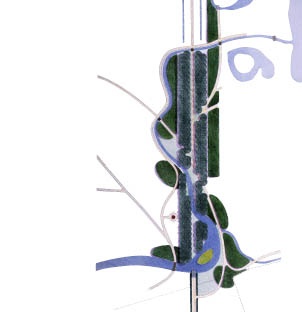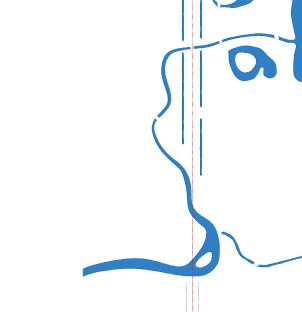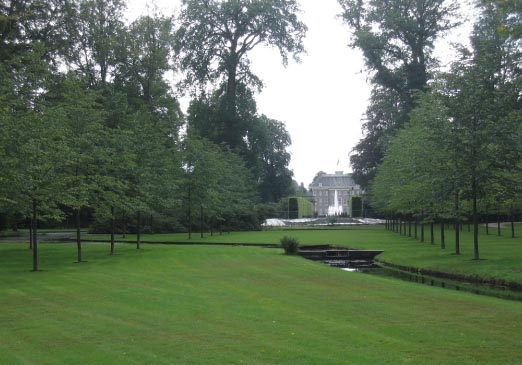

| Originally a hunting lodge, this palace in the heart of the Netherlands
was graced by a formal garden dating form around 1700. In the 1980’s,
following the reconstruction of the mansion, the grounds too were
brought back in Baroque style. Still lacking was a convincing
connection with the 19th century park to the north covering the
originally bare heath land. The assignment was to establish that link. The solution was found by reinforcing the avenue as an extension of the garden axis into the landscape, and connecting it with three structural lines there: a curving path, meandering brook and winding path. |
 |
| The curving path Connected to the axis of the reconstructed garden, this path transects the tree-lined drive at an oblique angle and continues in a northwestern direction. Its importance as a fault line in the formal landscape style is emphasized by taking a bend out of the curve and eliminating a second path that runs parallel. At crossings over water or with the avenue, clumps of rhododendrons and other hardy annual shrubs mark these special spots. |
 |
| The meandering brook Where the brook meets the axis of the garden and widens into a pond, a balcony hovering over the water provides the fluid hinge that connects 18th century geometry with 19th century romanticism. Azaleas cover the island in the pond to make it a jewel in the crown. |
 |
| The winding path After the curving path and meandering brook, the winding path is the third line structuring the landscape outside the garden. It follows the water on its way to the reservoirs in the fields. Coming from the pond the avenue is crossed for a second time. From here the path wanders into the park, to meet the water again at the relocated bridge. |
 |
| The Northern avenue Replanting 119 trees in line with those that remain along the avenue and deepening the ditches at both sides extends the central axis of the garden layout deeper into the landscape, apparently over the horizon. Garden and park are finally and forever united with each other and the world beyond. |
 |

Client
Royal Forest Het Loo
(Koninklijke Houtvesterij Het Loo)
Credits
Rob Lubrecht
Architectural designer